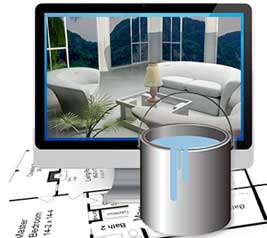Designs for Fabulous Parquet Floors
Thinking of adding hardwood parquet floors to your old house remodel? Ornamental parquet floors are really tongued-and-grooved strip-flooring carefully handled and specially worked until it is practically a cabinet-maker's product rather than the product of a flooring mill. The 19th century parquet flooring designs shown above are made so exactly to size that they can be used in various patterns by cutting into shorts and double-grooving or tongue-and-grooving the ends. Parquet floors are decorative hardwood flooring that is composed of flooring strips creating a so-called wood carpet. The general term wood mosaic is also applied to parquetry because the manner in which the strips, squares, etc. of wood are put together, is precisely the same as the putting together of tiles in tile mosaic work. See some parquet flooring pictures >>

Parquet Floors Designs
Decorative designs for parquet floors featured in old houses from 1899.

Parquet Flooring Designs
Parquet hardwood flooring creates a so-called wood carpet.

Parquet Hardwood Patterns
Choosing a parquet floor also puts you in the company of kings and queens.

Patterns for Parquet Floors
There are various parquet patterns that can be achieved in a parquet floor project.

Parquet Flooring Designs
Hardwoods for parquet floors are white oak, white maple, dark cherry, walnut, dark oak, red mahogany, and white mahogany.

Top Parquet Patterns
There are various parquet patterns that can be achieved in a parquet floor project.
Choosing a parquet floor also puts you in the company of kings and queens. Louis XIV's designers created a special pattern for the Versailles floors comprised of large squares of parquetry laid on the bias with intertwined diagonal squares within. The pattern is still recognized as Parquet de Versailles. Parquet patterns quickly became the flooring of choice as aristocrats throughout France installed individualized patterns in their chateaux. These parquet flooring designs are still known by the name of the estate where they were first installed. Some names include Chalosse, Chantilly, Fontainbleu, and Chantreuse. Today’s manufactures of wood flooring now offer both classic and modern designs. See beautiful antique hardwood flooring pictures >>
The decorative feature of hardwood parquet flooring, ignored in recent years as interior design focused more on uncluttered minimalist styles, is making a comeback. The term parquet flooring is applied to flooring composed of boards or strips tongued and grooved and laid and otherwise worked into strip patterns by the carpenter, in the same manner as a cabinetmaker would work. Including parquet floors in your design space, whether a living room (PHOTO), dining room or foyer, delivers immediate texture and interest to your floor.

There are various parquet patterns that can be achieved in a parquet floor project. Individual units in the Block design, first used in European castles, can have from three to seven wood slats. Four blocks set at right angles make the Standard Block design. The Herringbone pattern was designed for Louis XIV for his Hall of Mirrors at Versailles Hall of Mirrors at Versailles (PHOTO). Also popular are variations on the Haddon Hall pattern first laid in a centuries old British manor house and was also featured in the famous Haddon Hall Hotel in Atlantic City, NJ. The Monticello pattern (PHOTO), designed by Thomas Jefferson for his Virginia home, is a square bordered by double-mitered or pointed pickets. Spinoffs often have single-mitered (diagonally pointed) pickets. Two newer patterns, the Basketweave and Domino, complete the basic parquet palette. By varying the grains and colors of the hardwood that is used, designers can create a variety of looks from these basic patterns.
The woods ordinarily used for parquet and parquetry floors are plain white oak, quartered white oak, selected white maple, dark cherry, walnut, dark oak, red mahogany, and white mahogany. In certain special cases the so-called rare and fancy hardwoods are used. Parquet flooring strips are made at the mill so that the tongue and groove come in the middle of the edge of the strips or boards, a feature differing somewhat from that of ordinary hardwood flooring. This insures a tight, even contact of both top and bottom edges. In parquetry flooring, in addition to long strips, there are also pattern pieces of geometric formation and standard sizes, such as squares, rhombs (equilateral parallelograms having oblique angles), and herringbone patterns. Sometimes the effect is secured by veneering on a backing of pine or chestnut.
Special patterns in parquetry work are used both for fields and borders, their interest and elaborateness consisting of the different directions of the grain and the different colors of hardwoods used. These fancy parquetry patterns are made of strips, blocks, and sections of hardwoods of various colors, inch thick, glued edge to edge and backed by cloth or canvas. Many interesting patterns, for both fields and borders, can be made by the judicious use and matching of such woods as oak, walnut, mahogany, maple, etc. Fancy parquet floors of this kind are usually made up in sections 4 feet long and 12 inches wide, unless they are for narrow borders, and thus are taken to the building where the parquetry is to be laid.
